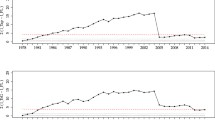Abstract
We develop a new method for the statistical estimation of the tail of the distribution of earthquake sizes recorded in the Harvard catalog of seismic moments converted to m W -magnitudes (1977–2004 and 1977–2006). For this, we suggest a new parametric model for the distribution of main-shock magnitudes, which is composed of two branches, the pure Gutenberg-Richter distribution up to an upper magnitude threshold m 1, followed by another branch with a maximum upper magnitude bound M max, which we refer to as the two-branch model. We find that the number of main events in the catalog (N = 3975 for 1977–2004 and N = 4193 for 1977–2006) is insufficient for a direct estimation of the parameters of this model, due to the inherent instability of the estimation problem. This problem is likely to be the same for any other two-branch model. This inherent limitation can be explained by the fact that only a small fraction of the empirical data populates the second branch. We then show that using the set of maximum magnitudes (the set of T-maxima) in windows of duration T days provides a significant improvement, in particular (i) by minimizing the negative impact of time-clustering of foreshock/main shock/aftershock sequences in the estimation of the tail of magnitude distribution, and (ii) by providing via a simulation method reliable estimates of the biases in the Moment estimation procedure (which turns out to be more efficient than the Maximum Likelihood estimation). We propose a method for the determination of the optimal choice of the T value minimizing the mean-squares-error of the estimation of the form parameter of the GEV distribution approximating the sample distribution of T-maxima, which yields T optimal = 500 days. We have estimated the following quantiles of the distribution of T-maxima for the whole period 1977–2006: Q 16%(M max) = 9.3, Q 50%(M max) = 9.7 and Q 84%(M max) = 10.3. Finally, we suggest two more stable statistical characteristics of the tail of the distribution of earthquake magnitudes: The quantile Q T (q) of a high probability level q for the T-maxima, and the probability of exceedance of a high threshold magnitude ρ T (m*) = P{m k ≥ m*}. We obtained the following sample estimates for the global Harvard catalog \( \hat{Q}_T (q=0.98)=8.6 {\pm}0.2 \) and \( \hat{\rho}_T (8)=0.13-0.20. \) The comparison between our estimates for the two periods 1977–2004 and 1977–2006, where the latter period included the great Sumatra earthquake 24.12.2004, m W = 9.0 confirms the instability of the estimation of the parameter M max and the stability of Q T (q) and ρ T (m*) = P{m k ≥ m*}.
Similar content being viewed by others
Author information
Authors and Affiliations
Rights and permissions
About this article
Cite this article
Pisarenko, V.F., Sornette, A., Sornette, D. et al. New Approach to the Characterization of M max and of the Tail of the Distribution of Earthquake Magnitudes. Pure appl. geophys. 165, 847–888 (2008). https://doi.org/10.1007/s00024-008-0341-9
Received:
Accepted:
Published:
Issue Date:
DOI: https://doi.org/10.1007/s00024-008-0341-9




